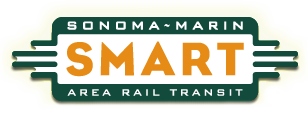SANTA ROSA, Calif. — Expansion of Northern California’s SMART commuter rail into Napa and Solano counties, allowing a connection to Amtrak, would take six years and about $1 billion, the Santa Rosa Press Democrat reports.
The figure comes from a study funded by the state of California into the possibility of a link from the current Sonoma-Marin Area Rail Transit station at Novato to to Suisun City, 41 miles to the northeast, to reach the Amtrak station served by Amtrak’s Capitol Corridor trains.
Sonoma-Marin Area Rail Transit currently operates 43 miles of its planned 70-mile system, offering daily service between the San Rafael Transit Center and Sonoma County Airport. It will eventually extend north to Cloverdale. In receiving the study, SMART’s board indicated it would not pursue such an expansion before completing the line to Cloverdale, which will require $364 million.
The study projects travel time of 60 to 90 minutes each direction on the proposed route, based on the level of track improvement. It looked at two levels of service — four daily round trips, serving an estimated 2,100 passengers, or 10 daily round trips, serving up to 5,400 passengers.
SMART already owns 25 miles of track paralleling State Route 37 which could be used for the extension.















Braden,
Thanks for the note. I’ll check this out if I’m ever in the neighborhood, which will probably be never. Braden with your sharp eye you didn’t notice I got the late mayor’s middle name wrong. It was Alexander. Not Aloysius. I’d explain my mistake but it’s beyond the scope of a trains blog.
I’m all for rail investment but agree that this is a terrible idea and I live in Bay area, work in Marin. Can think of at least three rail projects that this money would be better spent for the Bay Area and or connections to/from Sac.
As far as North Bay itself. HWY 37 has to be the priority. Been stuck on it plenty of times when Richmond Bridge traffic went sideways. It needs to rebuilt into 4 lane causeway w shoulders (future 3rd for commute traffic). For starters it would address climate change as Hwy 37 was shutdown for multiple days this winter due to flooding. Second, it is reliever for the aging Richmond bridge as one of the two north bay corridors. Finally, Hwy 37 as causeway would actually help the North Bay retain its marshes. At the moment it actually acts as a barrier and dam instead of letting North Bay marshes naturally protect against seal level rise.
As far as rail. Lets see, can add a third track through Richmond/Oakland to increase Caltrains capacity as well as freight capacity in and out of Port of Oakland, add more double track in the delta on way to Sac and or spend it on rebuilding Dumbarton rail corridor & add electric to literally add another bay crossing for Caltrains service from East Bay/South Bay into downtown San Fran
Mr. Landey,
There’s still some remnant of track left by Cobo Hall last time I was down there
The Trolley must have been moving at the same speed as the traffic???
A news channel did a comparison and the traffic still beat the train
State route 37 as well as the currently freight only tracks are being reclaimed by San Pablo Bay.
Gerald – a freeway would cost 3 to 4 times per mile, you post. It would also carry 30 times as many people.
Braden Kayganich
The problem with widening and turning State route 37 into a full freeway between Suisun-Fairfield and San Rafael is that it would cost about 3 – 4 times as much money per mile…and it would be at gridlock in less than a year.
Brett – The real test isn’t whether a car can beat a train, it’s whether a person on foot can beat the train. A year or so back, some goofs in Washington, D.C. decide to outwalk the city’s new trolley and they won.
Many years earlier, Detroit had its short-lived, long-forgotten downtown trolley (not to be confused with today’s Q-Line which came much later). This was the 1970’s when the city still employed veterans of the DSR –
Detroit Street Railway – decommissioned in 1956, so some guys still knew how to string trolley wire. The city bought two single-truck trolley cars that Oporto, Portugal was quite happy to get rid of. Something like two-foot gauge, part of the route was literally down the sidewalk of West Jefferson. The ride was worse than awful. Jimmy Carter’s Secretary of Transportation came to the ribbon cutting. If I remember his name was William Coleman. He was a comrade of Detroit Mayor Coleman Aloysius Young when both served in the Jim Crow army air force squadron in World War II.
From the intersection of Woodward and Jefferson, I paced the trolley west on Jefferson to where it turned on north on Washington Boulevard. Up Washington Boulevard I paced the trolley past West Larned, West Congress, West Lafayette, Michigan, and at a steady walk I was still keeping up with it past West Grand River. The end of the line at Grand Circus was in sight.
Then you know what, the thing barely made an amber traffic signal (what the other 49 states call “yellow”, in Michigan it’s amber). I had to stop and wait. The thing beat me to the end of the line. To this day, four decades later, I’m still furious.
You could ask every single person who lived in Detroit at the time if they remember the trolley. To the last man and last woman they would deny it ever happened.
$25million/mile….. To be honest this is better spent on highway expansion for greater VPD or BRT. Why spend this amount on an average of 3000 supposed passengers per day?? Sometimes you just gotta scratch your head….